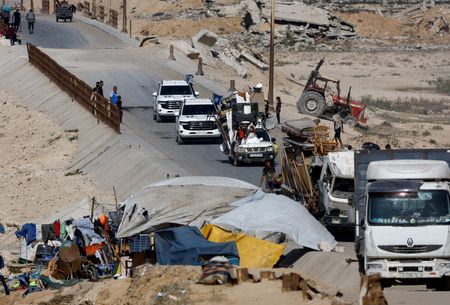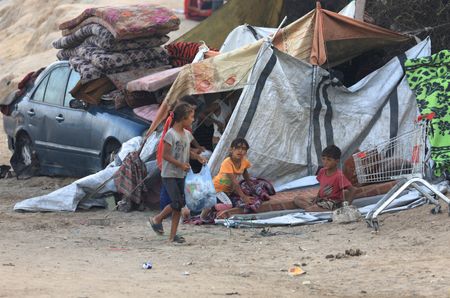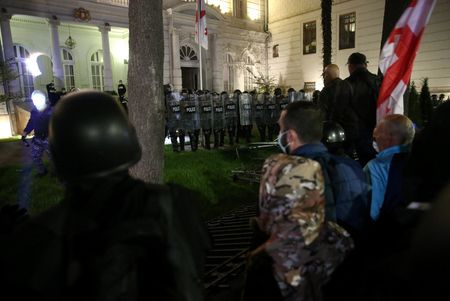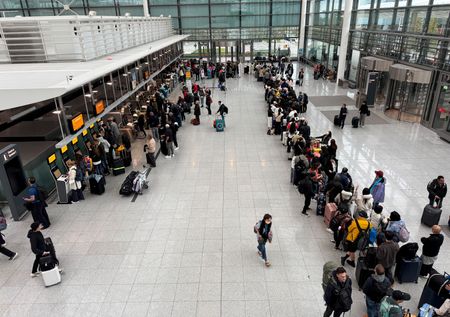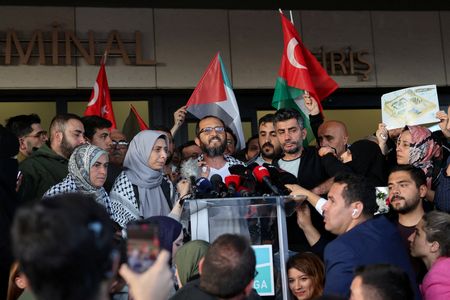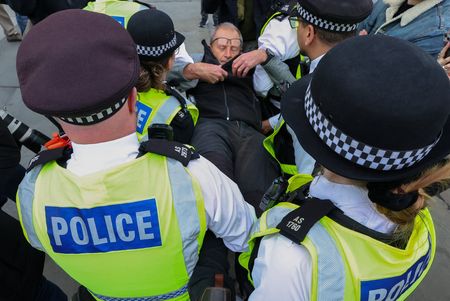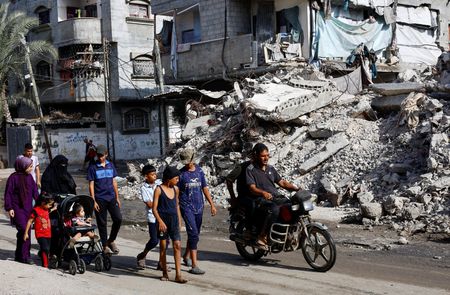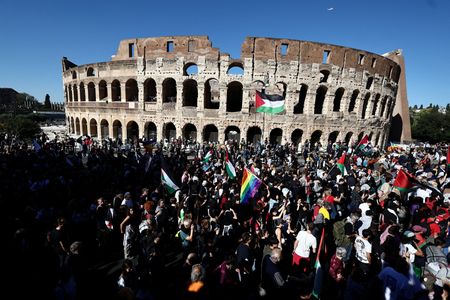(Reuters) -President Donald Trump has urged Israel to halt its bombing of Gaza after Hamas agreed to release hostages and accepted some key parts of a U.S. peace plan — a shift that could mean a two-year-old war is finally coming to a close.
Israel announced it would work on “immediate implementation” of the first stage of the plan, which Prime Minister Benjamin Netanyahu approved during a trip to Washington.
Yet potential pitfalls remain — the precise timeline for implementing Trump’s plan remains unclear, some logistics may prove problematic because of Gaza’s devastation, and issues such as Hamas’ disarmament and Israel’s withdrawal appear unsettled.
Previous ceasefires during the war came to an end with Israel reviving its offensive and fighting resuming.
WHEN COULD THE GUNS FALL SILENT?
It already seems calmer, despite some sporadic Israeli strikes.
After Trump’s demand for a halt to Israeli bombing, Gaza residents in the first hours afterwards reported heavy bombardments on Gaza City, which has been the focus of an intense Israeli offensive. Since then, residents say air strikes and other fire has dropped off dramatically, with periods of relative calm and only occasional blasts.
DOES THIS MEAN THE WAR IS FINALLY DRAWING TO A CLOSE?
Potentially. Trump has said he is determined to bring an end to the conflict with this 20-point plan, stating in his message on social media on Friday: “This is not about Gaza alone, this is about long sought PEACE in the Middle East.”
But this deal follows previous ceasefire attempts – one shortly after the war began in 2023 and another earlier this year – that lasted only a few weeks before war erupted again.
There are plenty of hurdles ahead this time too.
Hamas’s response left several key issues unaddressed. For example, the Palestinian militant group, whose attack on Israel in October 2023 sparked Israel’s offensive, did not make clear its position on disarmament, a key demand in Trump’s plan and one of Israel’s main stated objectives for the war.
Meanwhile, Benjamin Netanyahu gave his approval to the plan even though it offers a possible pathway, albeit a highly conditional one, to a future Palestinian state, something the Israeli prime minister has bluntly said he would never allow.
Other potential sticking points include the timing and boundaries for an Israeli withdrawal and future governance of the enclave.
Oren Setter, senior fellow at Harvard’s Belfer Center and former head of the Israel Defense Forces strategic planning division, said it was a significant achievement by Trump to get all the sides to engage with the plan, adding: “But it’s the beginning of the process. It’s not the end of the process.”
WHAT HAPPENS NEXT AND WHEN?
Trump’s plan did not give a very clear timeline.
The plan stated the war would end immediately once both sides had agreed to the proposal. However, Hamas’ response did not approve all of the 20 points, saying it would engage “through mediators, in negotiations to discuss the details of this process”.
The plan said all hostages, alive and deceased, were due to be released within 72 hours of Israel publicly accepting the agreement, but it was not clear at what precise point the clock on that 72-hour deadline would start ticking, given Netanyahu agreed to the timeline several days before Hamas responded.
There may be logistical challenges too. Sources close to Hamas say handing over living hostages could prove relatively straightforward, but retrieving bodies of dead hostages amid the rubble of Gaza may take longer than a few days to achieve.
Israel says 48 hostages remain in Gaza out of the 251 seized by Hamas in their October 2023 assault, 20 of whom are alive.
WHAT ARE THE POSSIBLE POLITICAL CALCULATIONS BY HAMAS AND ISRAEL?
Both Israel and Hamas seem intent on showing a positive response to Trump, but face their own political calculations.
For Netanyahu, agreeing to the plan may be based on a calculation that he can keep on the right side of Trump and the United States, Israel’s vital ally, while also conceding as little as possible to avoid alienating his religious nationalist coalition partners, who have been staunch opponents of any deal with the Palestinians and have long pushed to continue the war.
Meanwhile, the response by Hamas, which involves agreeing to release hostages but leaving several issues unresolved, may have helped shift the immediate focus to other players, including Arab mediators in the negotiations throughout the war, such as Qatar and Egypt, or other Arab or Islamic states who have been pressing the U.S. president to end the conflict, said International Crisis Group analyst Amjad Iraqi.
“Hamas has actually made rather a smart move by saying ‘yes and’ or ‘yes but’. In that kind of approach, they basically helped to kind of throw the ball back into the courts of Netanyahu, but also the Arab states,” he said.
HOW DOES HAMAS’S RESPONSE MEASURE UP AGAINST TRUMP’S PLAN?
Here is how the group addressed or sidestepped main points of the plan:
* Release of hostages: Hamas said it would release Israeli hostages in Gaza, both living and dead, according to the exchange formula in the plan, but referred to “the necessary field conditions for implementing the exchange”, without specifying what those conditions were.
* Israeli withdrawal: Hamas said it accepted the framework to end the war and referred to Israel’s “full withdrawal” from the enclave, while the plan said “Israeli forces will withdraw to the agreed upon line to prepare for a hostage release” and also referred to a “staged withdrawal”.
* Future governance: Hamas, which has ruled Gaza since 2007, said it would hand over Gaza’s administration to a Palestinian technocratic authority with Palestinian, Arab and Islamic backing, while the Trump plan said a Palestinian technocratic administration would be supervised by a new international transitional body, headed by Trump and including others such as former British Prime Minister Tony Blair.
* The future of Hamas: Hamas said it saw itself as part of a “comprehensive Palestinian national framework” and did not comment on demilitarisation, a move it has previously rejected, while the plan said Hamas would not have any role in the governance of Gaza and referred to a process of demilitarisation of Gaza.
(Reporting by Kanishka Singh in Washington and Pesha Magid in Jerusalem; Editing by Edmund Blair and William Maclean)

